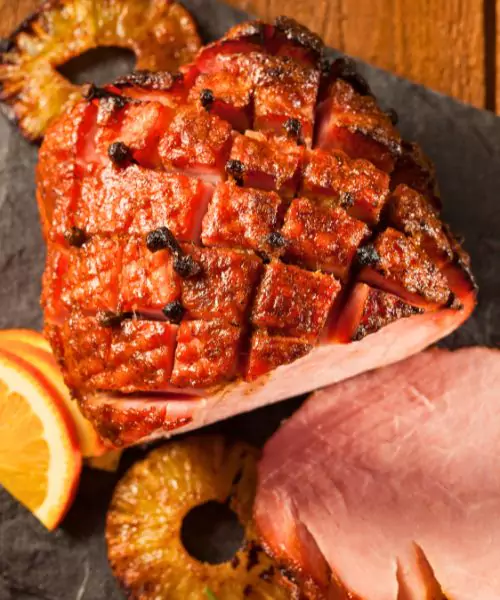Cooking a ham at home is easier than you think, and it makes for a delicious, hearty meal that’s perfect for holidays, special occasions, or even just a cozy family dinner. A beautifully cooked ham is juicy, tender, and full of flavor.
The real secret lies in slow heating, adding moisture, and finishing with a flavorful glaze that caramelizes in the oven.
This step-by-step guide will teach you how to cook a fully cooked ham from start to finish.
Let’s get started!
How to Cook a Ham
Ingredients
For the ham:
- 1 fully cooked ham (bone-in or boneless), around 6 to 10 lbs
- 1 to 2 cups of water, apple juice, or pineapple juice (for the bottom of the pan)
- Optional: whole cloves (for studding the ham)
For the glaze (adjust amounts based on ham size):
- ¼ cup brown sugar
- ¼ cup honey or maple syrup
- ¼ cup orange juice or apple juice
- 1 tablespoon Dijon mustard
- 1 tablespoon apple cider vinegar
- Optional spices: cinnamon, cloves, allspice, garlic powder

Instructions
- Thaw (if frozen): If your ham is frozen, make sure it’s fully thawed in the refrigerator. This can take 3 to 4 days, depending on size.
- Preheat your oven: Set your oven to 325°F (160°C). This low temperature helps warm the ham slowly and keeps it moist.
- Unwrap and prep the ham: Remove all packaging, including any plastic disk covering the bone. If there’s a thick layer of fat on top, trim it down to about ¼ inch. Score the fat in a crisscross diamond pattern using a sharp knife. This helps the glaze soak in and creates a beautiful look once baked.
- Place ham in a roasting pan: Set the ham flat-side down (if bone-in) or fat-side up (if boneless or spiral). Use a rack if you have one. Add about 1 cup of water, juice, or broth to the bottom of the pan. This keeps the ham moist during cooking and prevents the glaze from burning.
- Cover the ham: Tightly cover the pan with aluminum foil to trap moisture. Place it in the oven on the middle rack.
- Bake the ham: Heat the ham for about 15 minutes per pound. For example, an 8 lb ham would need about 2 hours. You’re aiming for an internal temperature of 140°F if it’s a pre-cooked ham. Use a meat thermometer in the thickest part (without touching the bone).
- Make the glaze while the ham bakes: In a saucepan over medium heat, combine the glaze ingredients. Let it simmer for 10 minutes or until slightly thickened. Stir occasionally to prevent burning. Taste and adjust sweetness or tanginess if needed.
- Glaze the ham: About 30 to 45 minutes before the ham is done, remove the foil and spoon or brush the glaze all over the surface of the ham. Return the ham to the oven uncovered.
- Caramelize the glaze: Continue baking the ham, glazing it every 10 to 15 minutes. This creates a shiny, sticky coating. If you like, you can turn the oven up to 400°F for the last 10 minutes to darken the glaze slightly—but keep an eye on it so it doesn’t burn.
- Let it rest: Once the ham reaches the right temperature and the glaze is caramelized, remove it from the oven. Cover it loosely with foil and let it rest for 15 to 20 minutes. This allows the juices to settle inside, making it more tender.
- Slice and serve: Use a sharp carving knife to slice the ham. For bone-in, cut around the bone in sections, then slice into even pieces. For spiral hams, slices will fall away easily as you carve.
Extra Tips for Perfect Cooking
- Choose a bone-in ham for the most flavor, especially if you want leftovers for soups or stews.
- Always add liquid to the pan—this helps keep the ham from drying out and adds flavor to the glaze.
- Scoring the fat isn’t just for looks—it helps the glaze penetrate and caramelize better.
- If your ham comes with a glaze packet, you can either use it or skip it and make your own for fresher flavor.
- Use a meat thermometer to avoid overcooking. Even pre-cooked hams can dry out if left too long.
- Letting the ham rest after baking is essential. It makes slicing easier and keeps the meat juicy.
- Save the leftover ham bone! It adds deep flavor to soups, beans, or collard greens.
Conclusion
Cooking a ham is one of the easiest ways to impress your guests and feed a crowd with minimal effort. All it takes is a good quality ham, a simple glaze, and a little patience.
By baking it slowly, keeping it moist, and glazing it during the last stretch, you’ll create a centerpiece that’s golden, sticky-sweet, and melt-in-your-mouth delicious. Plus, the leftovers are just as amazing the next day—if you’re lucky enough to have any.
Now that you know how to cook a ham the right way, you’re ready to bring this classic dish to life anytime the craving hits. Enjoy!